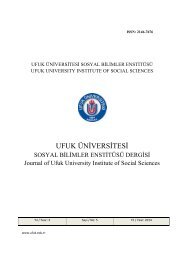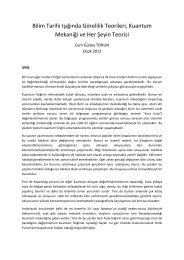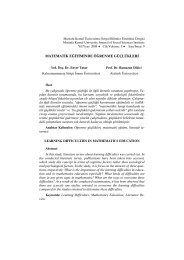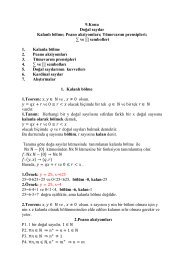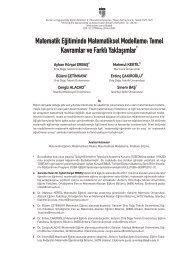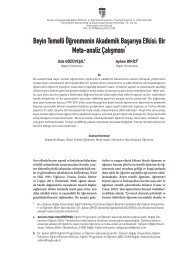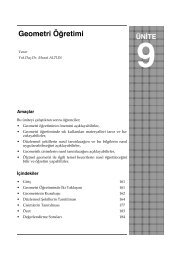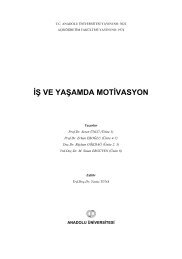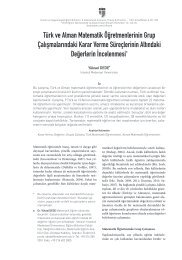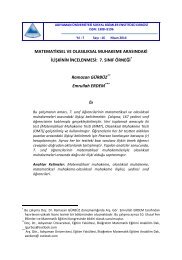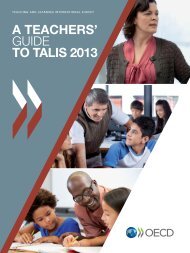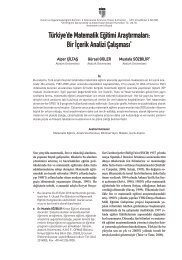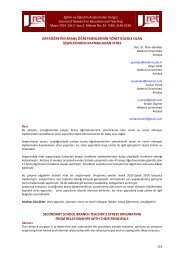NEWSLETTER
2015-12-98
2015-12-98
Create successful ePaper yourself
Turn your PDF publications into a flip-book with our unique Google optimized e-Paper software.
The EMS Jubilee: Challenges for the<br />
Next 25 Years<br />
Editorial<br />
Richard Elwes (EMS Publicity Officer; University of Leeds, UK))<br />
The roots of mathematics, like those of humanity itself,<br />
lie in Southern Africa. At the dawn of civilisation,<br />
thinkers in Mesopotamia and Egypt made early breakthroughs<br />
in notation and technique. Indian and Chinese<br />
mathematicians produced insights which remain with us<br />
today, while the Persian and Arabic traditions developed<br />
the subject over hundreds of years. Today, as in so many<br />
areas of life, the USA is a modern powerhouse. But, in<br />
our desire to give credit where it is due, and to honour<br />
the contributions of cultures which are too often overlooked,<br />
we should not get carried away. Our own continent<br />
of Europe has been home to a multitude of mathematical<br />
advancements since the time of Pythagoras. Just<br />
occasionally, it is worth reflecting and celebrating this<br />
glorious tradition.<br />
Indeed, many European nations have their own illustrious<br />
mathematical histories. In the 19th and early 20th<br />
centuries, this led to the founding of plethora of national<br />
and regional mathematical societies, of which the oldest<br />
surviving is the Dutch Koninklijk Wiskundig Genootschap,<br />
founded in 1778. The European Mathematical Society<br />
is thus a latecomer, not born until 1990 in the Polish<br />
town of Mądralin. This year therefore, our society has<br />
reached 25 years of age, a youthful milestone which was<br />
celebrated in magnificent style at the Institut Henri Poincaré<br />
in Paris, on 22nd October. The day opened with an<br />
address from the Society’s President, Pavel Exner, and<br />
comprised 4 plenary talks followed by a panel discussion<br />
on the state of European mathematics, as we look to the<br />
challenges of the next 25 years and beyond. Several of<br />
the themes from that conversation were well represented<br />
in the day as a whole, and perhaps it is worth drawing<br />
them out.<br />
A major focus was the need for mathematics to be an<br />
outward-facing discipline, in several senses. Every aspect<br />
of today’s society is influenced by life-transforming technologies<br />
whose design and operation relies on sophisticated<br />
mathematics. According to recent reports in UK,<br />
France, and Netherlands, the economic impact of Mathematics<br />
is enormous, to the tune of 9% of all jobs and 16%<br />
of Gross National Product. The market thus presents an<br />
unprecedented and growing demand for mathematical<br />
expertise, with data science in particular being an area of<br />
explosive growth.<br />
In his plenary talk, Andrew Stuart spoke eloquently<br />
about one pressing challenge in this arena: the relationship<br />
between mathematical models and data. Taking the<br />
example of numerical weather forecasting, a technology<br />
as technically demanding as it is socially important, he<br />
discussed the difficulty of incorporating observational<br />
data into theoretical models, giving appropriate weight<br />
The guests for the EMS Jubilee at Institut Henri Poincaré.<br />
Photo courtesy of Elvira Hyvönen.<br />
to both. He offered the opinion that mathematicians today<br />
stand in a similar position relative to Data, as they<br />
did to Analysis in the time of Fourier: we already have<br />
the basic language and techniques, but a revolution is<br />
surely imminent.<br />
Why do mathematicians do mathematics? In truth,<br />
the answer is not usually because of its societal benefits<br />
or economic impact. At an individual level, we do it because<br />
we enjoy it. Depending on your perspective, we are<br />
either playful people who enjoy amusing ourselves with<br />
puzzles, or deep-thinkers who provide answers to some<br />
of the most profound questions our species can ask. (The<br />
paradox of our subject is that this distinction is, in fact, no<br />
distinction at all.)<br />
The day saw two talks in this vein. The opening lecture<br />
by Hendrik Lenstra was an entertaining investigation<br />
of profinite number theory, meaning the structure<br />
of Ẑ, the profinite completion of the integers. One delightful<br />
discussion involved the profinite extension of<br />
that staple of recreational mathematics, the Fibonacci<br />
numbers. Generations of school-students and lay-people<br />
have been amused by this recursive sequence, and as<br />
Lenstra showed, there is plenty of enjoyment to be had<br />
for professional mathematicians too. (See his essay in the<br />
Newsletter of the European Mathematical Society 61,<br />
September 2006, 15–19.)<br />
In the afternoon session, we were treated to a talk from<br />
László Lovász on geometric representations of graphs.<br />
Here were beautiful problems and deep theorems, whose<br />
origins lie in puzzles accessible to school-children. He began<br />
with the theorem of Koebe that every planar graph<br />
has a circle representation: a set of non-overlapping discs<br />
EMS Newsletter December 2015 3




